
What to expect during your eye examination
To help you prepare for your eye examination, we have summarised what you can expect and why some of the tests are performed.
Why are eye examinations important?
Regular eye examinations are important to keep your vision and eye health in check. Your eye health can indicate wider health issues such as high blood pressure and diabetes.
To drive a vehicle legally, your vision must meet certain standards as defined by the Driver and Vehicle Licensing Agency (DVLA).
For certain occupations, your vision must meet specific standards to ensure that you can perform your role safely. Occupational vision standards apply to those working as pilots, firefighters, electrical engineers, drivers or police officers.
Certain medications, eye conditions or health conditions can alter your colour vision so it is important to consult an optometrist if you notice any changes.
An eye examination will show:
- how well you can see without spectacles;
- if spectacles can improve your vision or visual comfort;
- how well your eyes are working together and how well your eye muscles are functioning;
- if the major nerves related to your eyes are functioning well;
- if you see colours normally;
- if you could be sensitive to particular images or patterns;
- the health of your eyes;
- any other health issues that you might have.
An optometrist can prescribe:
- spectacles or contact lenses for distance vision or near vision;
- eye exercises to improve the coordination of your eyes and to improve visual comfort;
- eye drops to treat dry eyes;
- medication for eye conditions;
- a referral to your GP or a hospital service if required.
What do I need to bring to my eye examination?
Please bring:
- a list of any medication that you are currently taking;
- any paperwork from recent eye examinations (if you have had any).
What will my eye examination involve?
Your eye examination will involve a number of checks to assess your eye health and vision. Under the headings below we have outlined the different parts of the examination with a description, a photo and a video so that you know what to expect.
The optometrist in these videos is called Ketan, but you can use these to understand what to expect at your own optometric practice. Please also note that there may be members of staff other than the optometrist who conduct some of these tests.
On the day of the examination you might find that the checks happen in an order that differs from list provided below.
History and symptoms
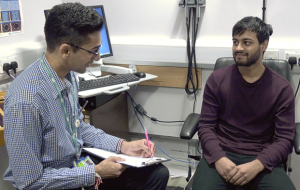 The optometrist will ask you:
The optometrist will ask you:
- whether you have noticed any problems with your vision or eyes;
- about your eye health, general health, family health and lifestyle.
Vision
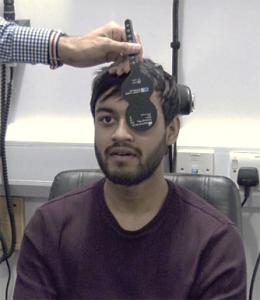 The optometrist will assess your vision by asking you to read from an eye chart displaying rows of letters. The letters at the top of the eye chart will be printed in a large size, gradually appearing smaller as you progress down the chart. The optometrist will then check your near vision by asking you to read words from a handheld chart.
The optometrist will assess your vision by asking you to read from an eye chart displaying rows of letters. The letters at the top of the eye chart will be printed in a large size, gradually appearing smaller as you progress down the chart. The optometrist will then check your near vision by asking you to read words from a handheld chart.
Eye muscle balance and coordination
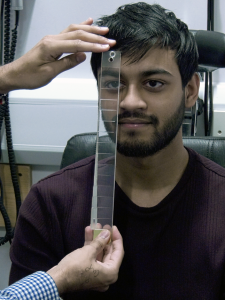 It is important to check that both of your eyes are working well together. If eye movements are not well coordinated, it can cause eye strain or blurred or double vision.
It is important to check that both of your eyes are working well together. If eye movements are not well coordinated, it can cause eye strain or blurred or double vision.
The balance and coordination of your eye muscles can be checked during a number of tests.
- Your eyes will be covered in turn (referred to as a ‘cover test’) while you focus on a target.
- The optometrist will ask you to follow a small light with your eyes while it moves in different directions.
- A specially designed ruler will be placed on your cheeks while you are asked to focus on a small cross target. This target will be gradually brought closer to your nose.
- The optometrist will place lenses in front of your eyes and you will be asked to judge the alignment of specified targets.
- The optometrist will hold a piece of equipment called a ‘prism bar’ closely in front of your eyes while you focus on a target. They will ask you to tell him when you start to experience blurry or double vision.
- You will be required to wear red and green coloured glasses and asked to identify 3D shapes from a book.
Assessing the need for glasses
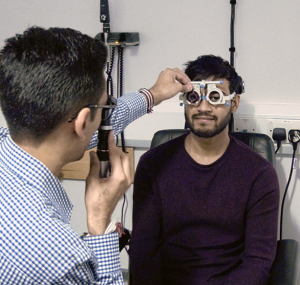
Optometrists can tell whether you need glasses by shining a light at your eye, referred to as a retinoscopy.
This test takes place in a darkened room. You will be wearing a special frame that allows the optometrist to place lenses in it.
They will shine a light at your eye from a short distance while you look towards a target.
Refining your glasses prescription
The optometrist will refine your glasses prescription by placing different lenses in front of your eyes and asking you if your vision feels better, worse or the same.
Once they have placed different lenses in front of your eyes, they will show you a letter chart and ask you to judge how well you can see the letters.
The same will be done to check your near vision, but this time you will be holding a reading chart with small text printed on it. Your glasses prescription will be determined by how well you can see using the different lenses.
Focusing ability
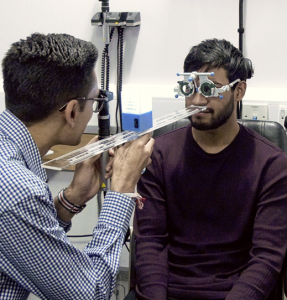 Focusing ability is required to be able to see things up close. This naturally decreases as we age and can cause difficulty reading.
Focusing ability is required to be able to see things up close. This naturally decreases as we age and can cause difficulty reading.
A range of tests can be conducted to check focusing ability.
The optometrist will place a ruler on your cheeks while you focus on a printed target. This target will be brought closer to your nose and you will be asked to tell the optometrist when your vision becomes blurry.
The accuracy of your focus will be measured while you look towards a target and a light is shone at your eyes from a distance.
Your eyes’ focusing speed will be assessed when the optometrist swaps lenses held in front of your eyes while you read from a handheld sheet.
![]() Watch a video of a test to check your eyes’ focusing ability.
Watch a video of a test to check your eyes’ focusing ability.
Colour vision
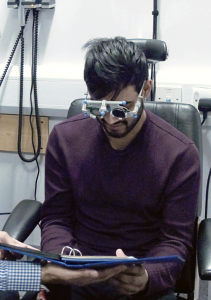 Throughout your life you can develop problems with recognising or matching colours accurately.
Throughout your life you can develop problems with recognising or matching colours accurately.
During this test you will be asked to compare coloured dots.
Sensitivity to patterns
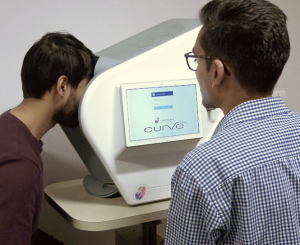 Some individuals can be highly sensitive to striped patterns. This can cause visual discomfort or ‘pattern glare’. A ‘pattern glare test’ is performed to check this and to pinpoint whether it may contribute to visual symptoms.
Some individuals can be highly sensitive to striped patterns. This can cause visual discomfort or ‘pattern glare’. A ‘pattern glare test’ is performed to check this and to pinpoint whether it may contribute to visual symptoms.
- The test requires you to look at three different striped patterns, each with different sized stripes. The optometrist will ask you whether they cause you visual discomfort.
- If you do experience pattern glare, Ketan will perform a test to determine if coloured lenses can help reduce the sensitivity. This test will require you to look into a machine to identify which colour makes your vision most comfortable.
Eye health
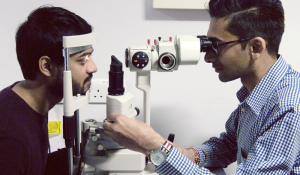 A range of tests can be conducted to check the overall health of your eyes.
A range of tests can be conducted to check the overall health of your eyes.
A microscope called a ‘slit lamp’ is used to examine your eyes closely. You will be required to place your chin and forehead against a rest and the optometrist will then move the microscope close to your eye to ensure they have a good view. They will then position lenses close to your eyes. Nothing will touch your eyes. However, the optometrist will need to touch your eyelids occasionally.
The optometrist will put orange dye in your eyes to help him judge the quality of your tears and give an indication of the health of the front of your eyes. This doesn’t sting and will be flushed out by your tears within about 30 seconds.
The optometrist will look through your pupil to check the back of your eyes. If your pupil is small and they find it difficult to check the back of your eyes, with your consent, they may administer eye drops to make your pupil bigger. The drops may sting at first and they usually take about 20 minutes to take effect.
The eye drops may temporarily blur your vision. Until they wear off, you may be more sensitive to light so we advise that you bring sunglasses. If the optometrist does need to administer these eye drops to you, we recommend that you avoid driving for at least six hours. If you have driven on the day of your eye examination, the optometrist can book another appointment for you on a date when you can arrange another means of transport.
The optometrist will photograph and scan the back of your eyes. You will be required to put your chin and forehead against a rest and, while keeping your eye still, a camera will be brought close to your eye. You will then see a bright flash which can dazzle you for a few seconds. The camera will not touch your eyes during this test.
Eye pressure
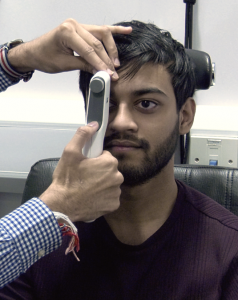 The pressure in your eyes is an indication of eye health. To test this, the optometrist will bring a piece of equipment called a ‘tonometer’ close to your eye and, although many patients do not notice anything at this point, you may feel a gentle tapping sensation on your eye. The tonometer does touch your eye but it is not painful.
The pressure in your eyes is an indication of eye health. To test this, the optometrist will bring a piece of equipment called a ‘tonometer’ close to your eye and, although many patients do not notice anything at this point, you may feel a gentle tapping sensation on your eye. The tonometer does touch your eye but it is not painful.
Field of vision
How will my eyecare provider prepare for my visit?
We have prepared recommendations for eyecare providers on how they can provide eye examinations better tailored for autistic patients. You can see these on the Our recommendations page. You may wish to inform your eyecare provider about these.

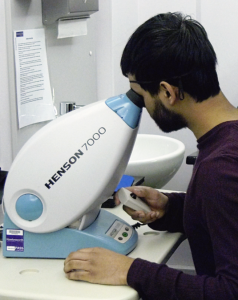 The optometrist will carry out a visual field test by asking you to look towards an orange or red target while white lights may appear around it. You will be required to cover one eye and press a button every time you notice the white lights appear.
The optometrist will carry out a visual field test by asking you to look towards an orange or red target while white lights may appear around it. You will be required to cover one eye and press a button every time you notice the white lights appear.